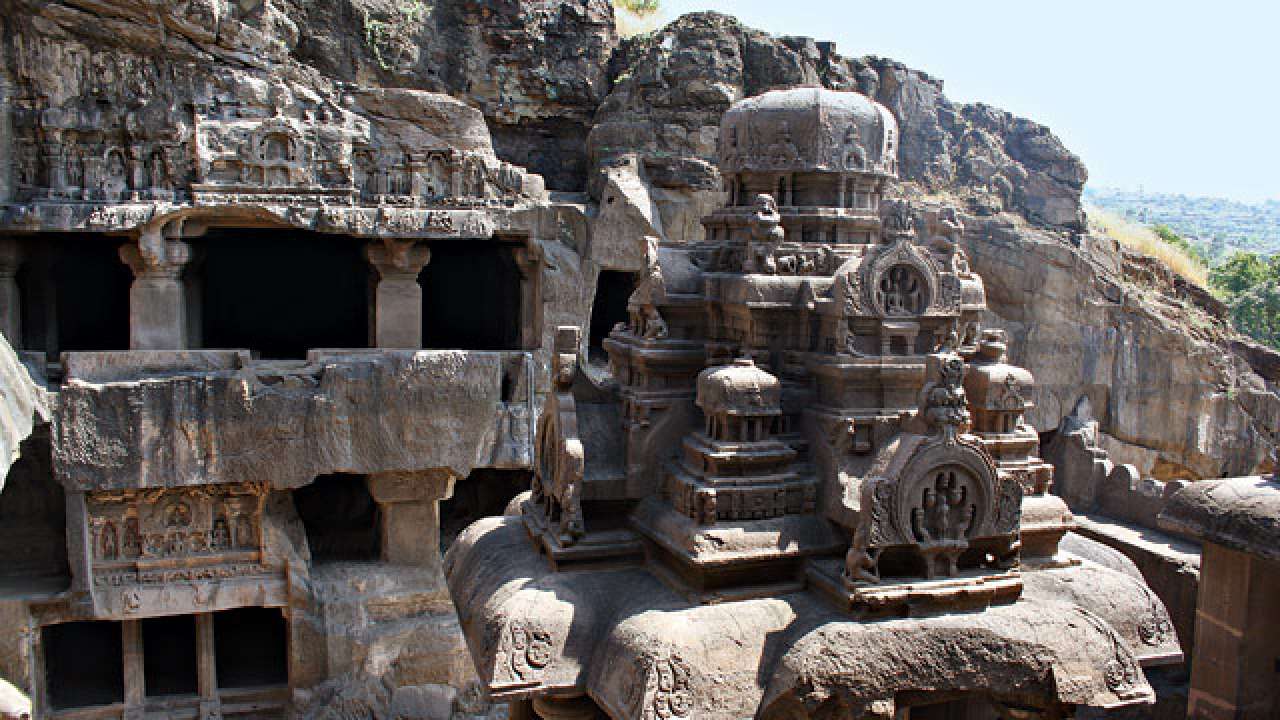
We continue with our Monsoon theme to go visit the UNESCO World Heritage site of Ellora barely 30 kilometres from Aurangabad. Ellora is one of the largest single rock cut monastic cave complexes in the world and contains the largest single monolithic excavation in the world, popularly known as the Kailasha Cave.
The Ellora caves were carved out of the terraces formed after millions of years of wind and rain erosion of the layers of volcanic flows from the Deccan Trap deposited one atop the other, as steps.
The royalty and nobility and those with means, commissioned the excavations while stone excavators, carvers, makers and painters of sculptures and engravings laboured there.
It is broadly agreed that the Ellora excavation started around the time when excavations at Ajanta were in their last phase, and lasted for 600 years, from 6th to 12th century CE.
Archaeological evidence from the region suggests continuous human settlement on the site from early stone-age. Major trade routes crisscrossed the area over 2,000 years ago, creating the ideal condition for locating the caves on this site.
Although there are a large number of caves spread across 2 kilometres, only 34 are open to tourists, and these include 12 Buddhist caves to the south, followed by 17 Brahmanical caves and 5 Jain caves to the north.
There is no clear demarcation between caves belonging to different faiths. 15 caves are grouped together, out of these the first 12 are Buddhist, the next three are Brahmanical. After a gap are caves 16 and 17, both Brahmanical, the former is the famous Kailasha Temple, a little to the north are two more Brahmanical caves numbered 18 and 19. Another small gap is followed by 9 Brahmanical caves numbered 20 to 28 across a stream called Elaganga.
The last Brahmanical cave numbered 29 come right after that. A large open space with a little eastward diversion from the main line of excavation and we reach cave 30, the first of the Jain caves, known as the Chhota Kailash.
Returning to the original line carving we come to a small cluster of 4 Jain caves numbered 31, 32, 33 and 34.
Ideally you should visit all the caves and spend time looking at the sculptures, carvings and engravings. While visiting Ellora, carry with you the slim ASI publication called Ellora, one of a series on World Heritage sites. It has all the necessary information, maps, photographs and drawings essential for a first time visitor.
If you are pressed for time, the ASI recommends 15 caves as a must visit, caves 6, 10, 11 and 12 from among the Buddhist caves, 14, 15, 16, 21, and 29 from among the Brahmanical caves and all the Jain caves from cave numbers 30 to 34.
In their depiction of themes, arrangement and details the Buddhist caves at Ellora are different from the caves at Ajanta. Cave number 10, popularly known as the Vishvakarma cave, is famous for its elaborate façade and is one of the finest examples of a Chaitya Temple, one also notices examples of appropriation with a few Buddhists caves later being converted into Brahmanical caves.
During the time of the dominance of Hinayna sect of Buddhism, Buddha was depicted as the Stupa, as seen at the first set of caves at Ajanta. By the time excavation at Ellora starts, Mahayana is the dominant influence and the image of Buddha is everywhere.
Among the Brahmanical caves, cave 16, known as the Kailasha, the greatest monolithic sculpture in the world, overwhelms the viewer with its magnificent proportions, workmanship and detailed carvings of battle scenes inspired by the Mahabharata and the Ramayana. One of the most reproduced carvings from Ellora, Ravan shaking Kailash Mountain — the throne of Shiva — is also a part of this monolithic carving.
Of the five Jain caves, two caves numbered 32 and 33, popularly known as Indra Sabha and Jagannath Sabha, stand out as imposing and intricately carved. No 32 — the south facing cave — is the most interesting Jain cave at Ellora, easily identified by the monolithic Mandapa, open on all four sides and located at the centre of the courtyard. The cave is known for its imposing image of Mahavir, the numerous carvings of the Tirthankaras, Yakshas, Yakshis, elephants, lions and other images connected with Jain mythology.
The author is a historian, and organises the Delhi Heritage Walk for children and adults